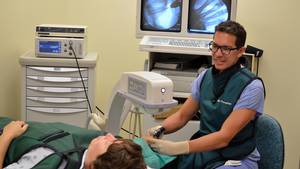An evening out on the town may begin with a few friends having drinks, but it sometimes ends with a devastating, life-altering brain injury.
This is the reality seen by neurosurgeon Dr. David Clarke and his colleagues.
"Many of my patients wind up seeing me because of binge-drinking and poor decision-making," explains the Interim Head of Neurosurgery and Director of the Neurotrauma and Injury Programs. “These are people who were out having a good time, and all of a sudden they have a brain injury with lifelong consequences.”
Ginette Thibault-Halman, research coordinator for neurotrauma and injury prevention programs, and her team, review brain injury cases every week. She says it's “not unusual” for them to see 50 per cent of the cases involving alcohol. Thibualt-Halman says this is why the brain injury prevention program is shifting to include the underlying causes of injury, such as alcohol.
"It really keeps coming up over and over again," says Thibault-Halman.
The team reviews all major brain injuries that are admitted to the QEII, which can range from a severe concussion to serious bleeding requiring surgery. "The consequences can range from a seemingly mild injury, with significant effects for patients (headaches, visual disturbances, irritability, personality changes, seizures), to the more severe injuries which can leave patients with a very high level of disability, some requiring complete institutional care," she explains.
Lynne Fenerty, research manager for neurotrauma and injury prevention programs, explains that brain trauma patients admitted to the QEII are often tested for alcohol consumption because it's important in sorting out the neurological condition of the patients.
“We know alcohol has sedating effects, so someone who incurred a brain injury while under the influence may be extremely drowsy,” says Fenerty. “Knowing whether they have alcohol in their system, or not, is important for developing an appropriate treatment plan. Alcohol is the cause of many traumas, but it also can complicate the treatment.”
Falls and collisions are the most common sources of brain trauma. A recent study showed that brain trauma patients over age 40, who tested positive for alcohol, have a higher rate of death than patients with the same level of injury that do not test positive.
While there’s more awareness about concussion and its effects, particularly following intense media coverage of Sidney Crosby’s injury, Fenerty says most people don’t realize the severity of the full spectrum of brain injuries.
“Concussions, in particular, can have delayed symptoms, especially if you go right back to your usual activities and then you realize you do have symptoms from the concussion. In this case you will need to rest your brain and gradually increase your activity. Even a seemingly mild concussion can have long-term consequences and requires adherence to appropriate management.”
Some brain traumas don’t present symptoms right away, which is why many people don’t feel the need to go to the hospital or their family doctor for a check-up, says Fenerty.
“These can be bad, devastating injuries for patients and their families. The biggest thing with the brain is that every bit of that anatomy is so precious to who you are.”
In 2009, actress Natasha Richardson suffered a head injury while skiing at Quebec’s Mont Tremblant Resort. She felt fine and declined medical attention, but later began experiencing headaches. She died three days later from an epidural hematoma.
“People can change very fast. They can feel fine at first, and then go downhill very quickly,” says Fenerty, “or they may have delayed symptoms, so if someone develops symptoms after a trauma, it’s important to seek medical attention."
Studies show that alcohol is a contributing factor in brain injuries suffered through motor vehicle crashes, falls and assaults. Fenerty says the downtown bar scene is “touted as a fun place,” but the surplus of bars, coupled with the late hours and at-home “pre-drinking”, can lead to serious injuries.
As a Health Promoter, Dan Steeves works with communities to try to decrease the amount of harmful alcohol use. According to the 2007 Nova Scotia Alcohol Strategy, the harmful use of alcohol costs Nova Scotia taxpayers close to half a billion dollars each year.
“We tend to be a culture of binge drinkers, rather than drinking in moderation,” says Steeves. He says the recommendation is to consume no more than three drinks (for women) and four drinks (for men) on any single occasion toreduce the risk of injury and harm.
“We’re driving people to quick intoxication. Young people are looking for the cheapest alcohol they can find, and what they can afford often has high alcohol content,” says Steeves. “Plus, the advertising shows how great your life can be with alcohol in it, and it rarely, if ever, indicates some of the harmful consequences.”
Fenerty says healthcare professionals are encouraging people to remember that alcohol is a drug that can be harmful to your health in the short and long-term. “We see preventable brain injuries that occur as a direct result of alcohol use. We want people to really consider the effect alcohol has on their life and their families’ life, and society at large.”
“There needs to be a shift in our culture. We want people to be much more respectful of alcohol, and treat it cautiously,” says Steeves. “Make your evening about the event, about the music you’re going to hear, or the friends you’re going to be with. When did it all become about the alcohol?”
Dr. Clarke says the vast majority of brain injuries are preventable and our society needs to create a solution to address the causes.
“There are parallels with helmet use – it’s not enough to simply tell people it’s dangerous not to wear a helmet,” says Dr. Clarke. “We need to acknowledge that there is a major problem with alcohol, and develop strategies that will curb this kind of unnecessary and tremendously costly brain trauma.”








